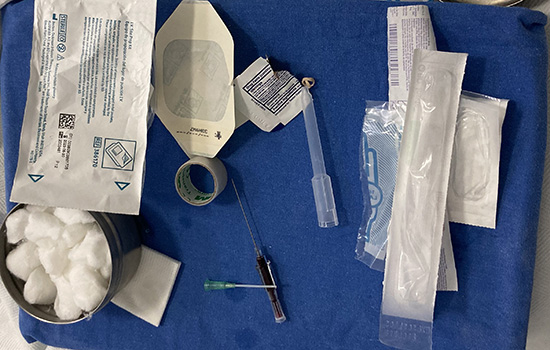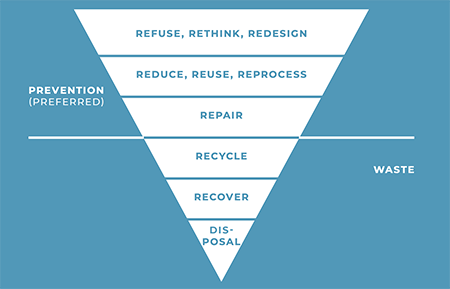Plastics and health
Plastics are one of the most severe environmental pollutants. According to the United Nations Environment Programme (UNEP), nearly one million plastic bottles are purchased every minute, up to five trillion plastic bags are used worldwide yearly, and half of all plastic produced is designed for single-use purposes.
The health care sector is an avid consumer of plastics, many of which are unnecessary or overused. After use, if not adequately managed, plastic waste ends up in landfills or incinerated, entering the soil and water streams and contributing to air pollution.
Plastics are present in everyday products ranging from syringes, surgery gowns, and gloves to the packaging used to wrap food. Some truly life-saving devices, particularly intravenous (IV) kits and blood bags are often made of polyvinyl chloride (PVC) and Di (2-ethylhexyl) phthalate (DEHP), two chemicals with proven adverse effects that may end up entering the patients’ bodies when IV bags are used. Plastics can negatively affect human health and the environment at every stage of its life cycle.

How can the health care sector reduce its impact?
Health Care Without Harm works with health care systems and professionals to address the impact of plastic use in the sector through different actions:
- Sustainable procurement and replacement for safer alternatives
- Reducing the use of unnecessary plastics and waste management
- Market transformation
- Policies
Learn more about our resources
1 - Sustainable procurement and replacement for safer alternatives
Since the 1990s, Health Care Without Harm has worked with the health care sector to address the use of toxic plastics, such as PVC, and hazardous chemicals, like phthalates and bisphenol A, which are endocrine disruptors and should be prohibited in health care plastics.
Health Care Without Harm has also produced resources, including guidance documents and tools on plastic waste and initiatives to reduce the overuse of products such as gloves and PPE. The organization also works in partnership with a network of hospitals, assisting them in improving their practices and mobilizing health care professionals as advocates for sustainable, non-toxic, and climate-smart approaches. Learn more about our resources.
2 - Reducing the use of unnecessary plastics and waste management
Health Care Without Harm promotes a waste hierarchy focused on redesigning, rethinking, and eliminating unnecessary products as a critical first step in addressing the plastics crisis. This framework calls for the following:
- Elimination of all problematic and unnecessary plastic items,
- Innovation to ensure that the plastics we do use are reusable, recyclable, or compostable
- Promote that plastics that are being used are maintained in the economy and out of the environment for as long as possible.

Image: Health Care Without Harm Europe (2021) Measuring and reducing plastics in the healthcare sector
Products must be non-toxic to avoid continually recirculating hazardous chemicals through the economy and the environment.
- Plastics that cause the most significant environmental and human health damage should be phased-out.
- Single-use plastics should be avoided.
- Polymers should be able to be recycled to a high standard using local infrastructure.
- Packaging reduction and prioritizing reusable schemes are crucial.
Health Care Without Harm and its partners promote safe recycling as a central part of sustainable health care waste management. As much as one-third of the waste can be recycled, and another third is organic, which can be biodigested, leaving only one-third needing to be landfilled. Learn more about our resources.
3 - Market transformation
Health Care Without Harm’s market transformation work is devoted to:
- Facilitate implementation of the sustainable gloves criteria, including spurring and assisting pilots in all SHiPP regions and identifying global agency opportunities for glove criteria adoption.
- Use plastic procurement and waste audits to identify and prioritize plastics reduction, including promoting principles for waste.
- Address PVC as a plastics priority for reduction and elimination.
Learn more about our resources.
4 - Policies
Health Care Without Harm is an observer of the Intergovernmental Negotiating Committee (INC) on Plastic Pollution. Health must remain a central part of the discussion as the world develops and adopts an international legally binding instrument on plastic pollution. Download our position paper on plastics and health.
Key actions can be taken by the health care sector - including ministries, hospitals, manufacturers, suppliers, health professionals, and others - to solve the health care plastics crisis.
Some of the priority actions are: a) reducing and redesigning health care plastics, b) enabling a circular economy for plastics, c) achieving environmentally sound management and recycling of plastic waste, and d) elevating the voices of health professionals as trusted messengers.
Learn more about our resources.
As countries and international organizations are working towards a new plastics treaty, it is essential to remind that there must be NO exemptions for plastics in health care.
Working with health care professionals
As trusted voices in society, health care professionals play a pivotal role to raise community and institutional awareness on the impacts of plastic pollution. By making decisions and advocating for reduced plastic production and consumption, proper waste management, and the promotion of sustainable alternatives, health professionals can help mitigate the health risks associated with plastics. Their advocacy can drive policy changes, influence consumer behavior, and pave the way for a healthier and more sustainable future for individuals and communities worldwide.
Health Care Without Harm leads and co-leads different professional networks advocating for healthier systems and practices, and develops different campaigns, guidelines, and resources to support their work.
